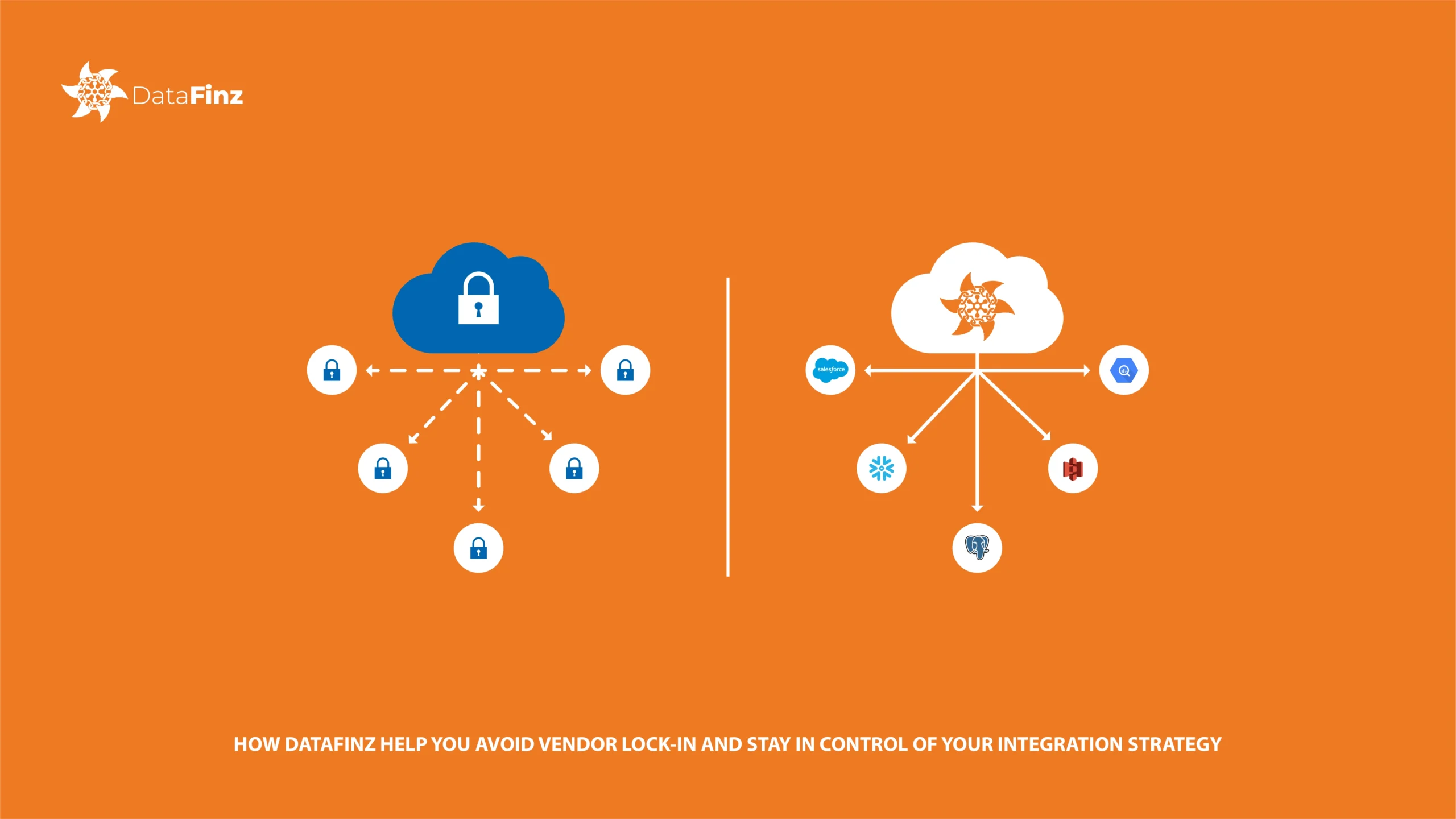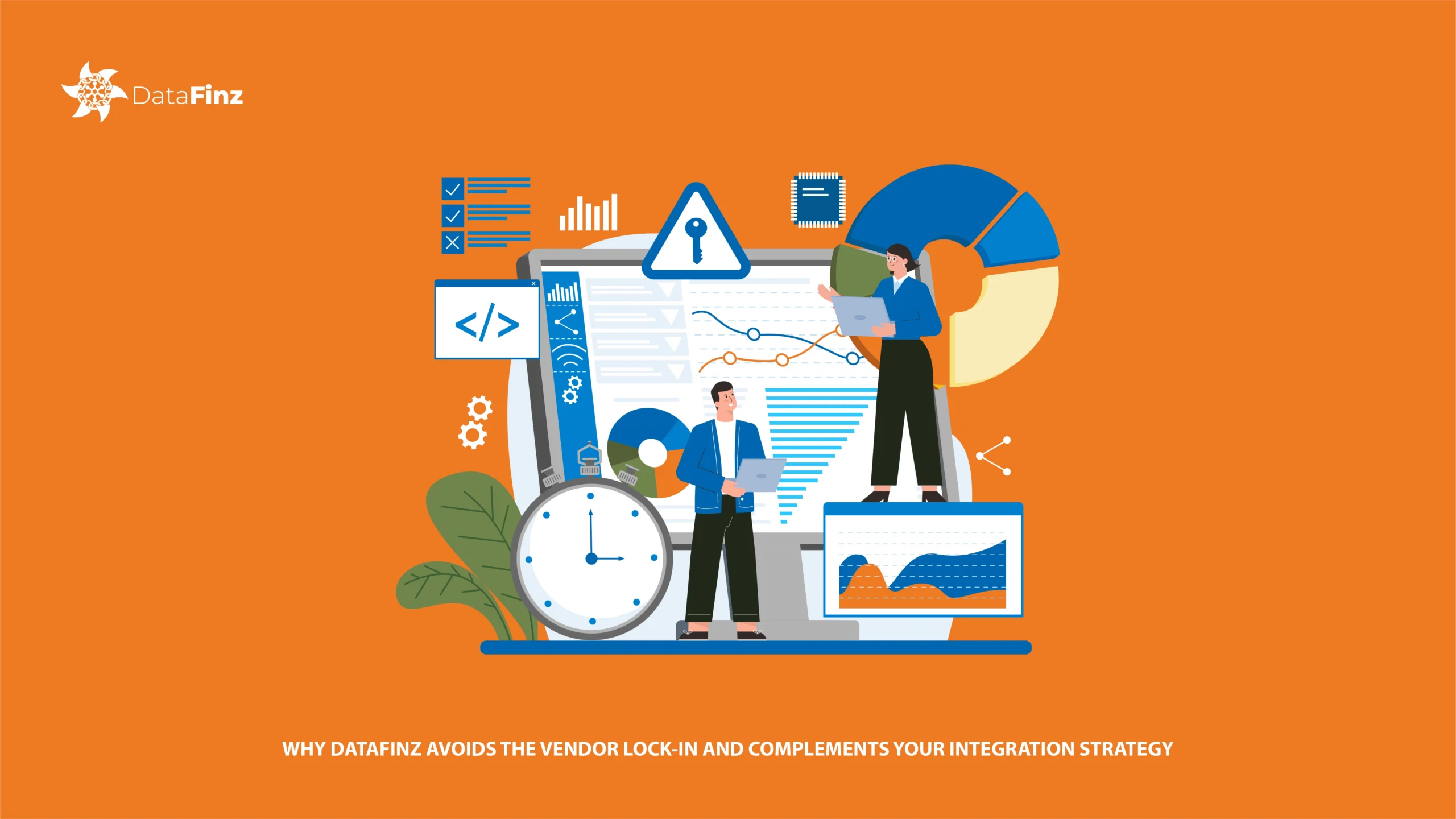Imagine you are steering a small retail, healthcare, SaaS, or supply chain business. Your team is juggling data across CRMs, ERPs, patient systems, or shipment platforms, aiming to deliver real-time insights or tap into generative AI for personalized offers, patient care, or logistics forecasts. You are intrigued by no-code platforms like DataFinz to streamline this chaos, but there’s a worry nagging at you: What if we get locked into one vendor, stuck with a tool that limits our options down the road?
It’s a fair concern that nobody wants their data trapped or their strategy boxed in. This is exactly where vendor lock-in becomes a critical factor in any integration strategy. Here’s the good news: DataFinz is designed to keep you free, working hand-in-hand with your existing tools and making it easy to pivot if needed. Let’s walk through how we make that happen.
The fear of vendor lock-in is real, especially when data integration is the backbone of modern businesses. Recent industry moves, like the $8 billion Salesforce-Informatica acquisition, highlight how critical it is to connect data seamlessly. But getting stuck with a platform that uses proprietary formats, clashes with your current stack, or demands heavy rework to leave can drain time and budgets.
Industry stats show 60% of IT folks hesitate over new tech due to lock-in risks, and manual integrations already eat up to 70% of IT budgets. Whether you’re syncing Shopify inventory, tracking patient data, or pulling supply chain shipment updates, you want a solution that fits your world now—and doesn’t hold you hostage later.
The rise of no-code vendor lock-in concerns has made teams cautious. Choosing a vendor that limits data portability or doesn’t support open formats can lead to high switching costs. That’s why modern teams look for platforms that support best database solutions for vendor lock-in and portability.

Unlike some no-code platforms that pull you into their ecosystem, DataFinz is built for openness and flexibility. It’s designed to complement other iPaaS platforms or custom APIs while letting you stay agile. Here’s how:
DataFinz doesn’t ask you to replace your integrations—it enhances them. With our pre-built connectors, it links to Salesforce, Snowflake, Shopify, CRMs, SAP, or ERPs without friction. For example, a retail team can sync inventory from Shopify to an ERP alongside no-code platform workflows. A supply chain business can stream shipment data to a dashboard while keeping existing ERP integrations. In healthcare, firms can move patient data to Snowflake while using other iPaaS for analytics.
Our Change Data Capture (CDC) and streaming capabilities ensure real-time data flows smoothly, no matter what else you’re running. This is a perfect fit for businesses that want to avoid vendor lock-in in cloud ecosystems.
We stick to industry-standard formats like JSON, XML, and CSV, and use REST APIs to keep data accessible. Features like data profiling and format conversion ensure your data is clean and ready to move anywhere, whether it’s customer insights for SaaS or supplier info for supply chain logistics.
Need to export to BigQuery or another platform? It’s ready without reformatting, so you’re never locked in. This makes DataFinz one of the best database solutions for vendor lock-in and portability, offering unmatched data storage management flexibility.
If you ever need to move on, DataFinz makes it simple. Our operational dashboards and data versioning at the record level track pipelines and changes, giving you clear documentation. Pipelines are built with open standards, so you can recreate them in other tools with minimal effort—industry trends suggest 70% less rework compared to proprietary systems.
A SaaS team moving analytics or a healthcare provider shifting patient data can do it in days, not months. This flexibility is critical when avoiding long-term vendor lock-in while maintaining a strong integration strategy.
Want to use generative AI for retail campaigns, SaaS content, healthcare diagnostics, or supply chain predictions? DataFinz’s REST APIs, CDC, and streaming connect data to AI models (e.g., AWS Bedrock, Google Vertex AI) without tying you to one AI vendor.
Switch AI providers, and your pipelines stay intact, helping you avoid the pitfalls of vendor lock-in in cloud AI environments and supporting seamless data storage management across platforms.
DataFinz offers cloud and on-premises options, letting you control data storage based on business needs. This is a win for healthcare teams meeting HIPAA rules or supply chain businesses prioritizing compliance.
We also support TLS 1.2+ encryption to protect your data while it moves, and AES-256 encryption to secure it when stored, giving you the confidence of a modern security layer without getting tied to a specific infrastructure or vendor lock-in cloud environment.
By choosing DataFinz, your team gets more than freedom—you unlock practical benefits with a flexible, no-code ELT platform at your side:
From data storage management to flexible pipelines, DataFinz delivers one of the most efficient ELT platforms designed to avoid no-code vendor lock-in.
We know technical teams value control and agility. DataFinz fits into your world, not the other way around. We’re a no-code ELT platform helping SMBs unify data, build APIs, and power AI with flexibility at heart.
Visit our resources and see how DataFinz fits your integration strategy—without the vendor lock-in.
What is vendor lock-in in data integration?
Vendor lock-in happens when a platform’s proprietary formats, APIs, or contracts make it costly or complex to switch providers. In data integration, this might mean data trapped in a unique format or high migration costs, limiting your options.
Is vendor lock-in really a risk when choosing a no-code data integration platform?
Yes, some no-code platforms use proprietary systems that restrict data portability, but DataFinz avoids this with open standards like JSON and XML, ensuring you can integrate and exit easily.
Is a no-code data integration platform like DataFinz only for non-technical users?
No, DataFinz serves both non-technical users and IT teams. Its visual interface simplifies workflows for business users, while features like REST APIs and CDC support technical teams’ advanced needs.
What happens if my current no-code data integration platform makes it difficult to export data or migrate to another cloud provider?
With a restrictive platform, you could face weeks of reformatting or data loss. DataFinz prevents this by using portable formats and clear pipeline documentation, cutting migration effort by 70%.
How does DataFinz help avoid vendor lock-in in data warehousing and integration platforms like Snowflake or Databricks?
DataFinz connects to Snowflake and Databricks via open APIs and standard formats, letting you move data freely. Its pipelines are reusable, so you can switch platforms without starting over.

